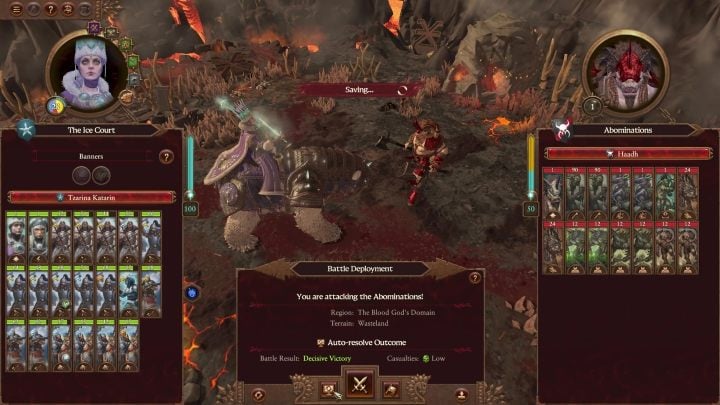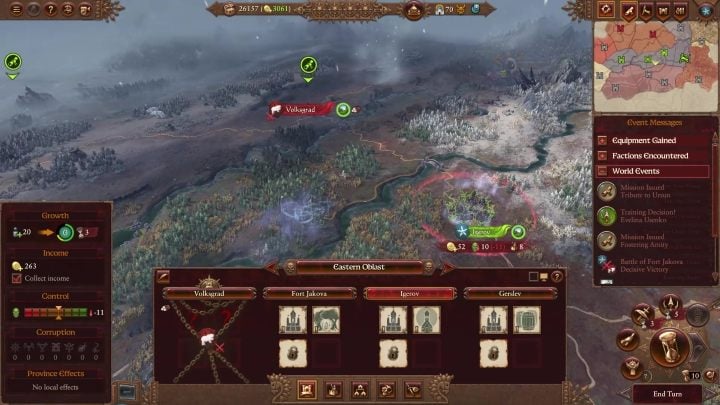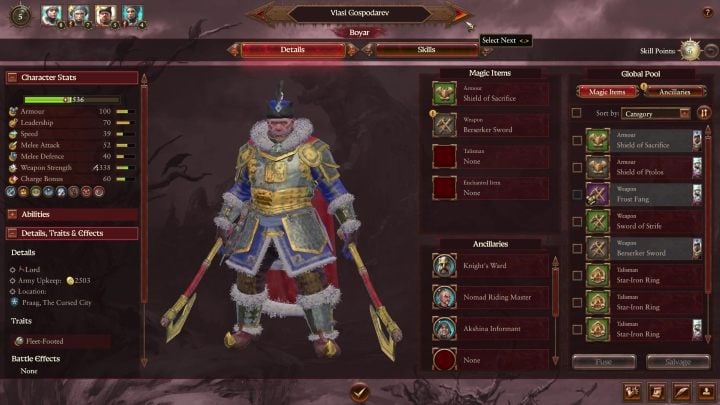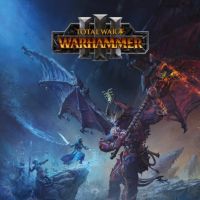Total War Warhammer 3: Beginner's guide
On this page you will find tips for begginers for Total War Warhammer 3, which can be useful not only for new players but also for those more experienced.
Below you will find a collection of useful tips that will help you start Total War Warhammer 3, regardless of whether you are an experienced player or someone who is just starting with the series.
- Think about the composition of your army carefully.
- Divide your armies
- "Refresh" the army
- Don't forget about the economy
- Have at least one hero in each army
- Merge provinces
- Use groups
- Don't treat cavalry as regular infantry
- Flank and attack from behind
- Take your time with making the second army
- Don't start unnecessary wars
- Check your inventory regularly
- Think carefully before deploying your troops
- Close rifts
- Prioritize development
- Take care of logistics
- Don't ignore magic
Think about the composition of your army carefully.

Different types of units have different uses. Cavalry/monsters will swiftly attack the enemy's rear/flanks, infantry will stop the attack, and archers and artillery will decimate the enemy before they even reach you, etc.
You can read more about the army on the Units page. The Military section also has pages related to separate factions.
Divide your armies
In the later parts of the game, divide your armies into offensive and defensive ones. At some point, your borders will become so large that you will want to defend them and conquer new lands at the same time. There is no quick way to move the army from one end of the map to the other, so the only option is to leave some of it to keep defending your territory.
"Refresh" the army
As you acquire new technologies and construct new buildings, try to "refresh" your units from time to time. Units that are in perfect condition at the start of the game may not work as well over time, or you may find much better alternatives. Don't be afraid to switch out some of your units for new ones.
Don't forget about the economy
Remember that maintaining an army costs money, and accepting each new lord increases your military expenses by 1%. At first it doesn't seem like much, but it will quickly become a large amount. This advice is especially important in the beginning when you are not yet engaged in numerous and huge battles to profit from. Therefore, do not train more armies than necessary, unless the profits from the war exceed the costs.
Have at least one hero in each army
Armies are managed by lords, but heroes can be very useful as they add bonuses for soldiers (depending on their class). Some will speed up losses replenishment, others will train units etc. In addition, they can deal with enemy agents who can weaken your troops.
You can read about the heroes in the Lords and heroes section.
Merge provinces

The province system was added in the Total War series some time ago. Most of them consist of several smaller areas - the capital and settlements. Unfortunately, you will only get the full management potential after you conquer the entire region.
You can read more about the provinces on the Provinces page.
Use groups
This skill will be especially useful in multiplayer games and if you play battles in realism mode, which makes it impossible to slow the game down. It is worth putting some effort into learning these rules at the very beginning of the game, because it will be much more difficult to break bad habits later.
- Classically, groups are created using ctrl + number from 1 to 9. We can select the entire army using ctrl + A, individual units using ctrl + LPM on them, the same type of units by pressing LMB twice (especially useful in the case of ranged troops, because you usually try to shoot at one enemy unit to chip its morale away as quickly as possible). Once you prepare groups and formations and want to move the entire army without breaking these formations, click ctrl A, then hold alt and click RMB at the intended location.
- The group can be closed or open, symbolized by the padlock icon next to the unit portrait. The type of group affects its behavior when issuing attack or march orders. Closed groups will retain their formation when moving to other positions, and in the event of an attack, they will not focus on the enemy unit indicated by you with the cursor, but each unit will direct its attacks at the group of enemies nearest to it. This will avoid the so-called "blobbling", i.e. gathering of units into an irregular mass that may become an easy target for artillery, magic or flank attacks.
- By pressing the "L" key you will unlock access to unit cards, where you can view detailed statistics; just hover the cursor over the unit. This will allow for a quick analysis of the unit's strengths and weaknesses and adjustment of strategy.
- The basic relations of different units can be described as a game of rock, paper and scissors. Units in Total War are designed to counter other, specific units. Large units such as beasts and cavalry take extra damage and are easy targets for all kinds of polearms, dual-wielding infantry will quickly cut through other infantry units, large weapons (halberds, two-handed swords and axes) will penetrate the toughest armors, while archers will become feed for crows after a cavalry charge. There are also combinations of the above and nuances between them, but if you have any doubts about the strategy, this principal division should apply in most cases. Unit type icons are displayed on squad banners.
Read more about the keybinds on the Controls page.
Don't treat cavalry as regular infantry
Cavalry is a fast unit that deals the most damage while charging. Its combat abilities drop significantly when engaging in regular close combat. It is best to withdraw your troops immediately after the attack, move them away and start the attack again - and so on. Especially if you are dealing with an assault cavalry. Horse units are also ideal for attacking enemy archers and artillery.
Flank and attack from behind
Always try to have some fast units in the army that can flank the enemy or attack them from behind when they are engaged in fighting with your infantry. Not only you are able to deal more damage to the enemy, but you will also significantly weaken their will to fight - no one likes to be surrounded.
Take your time with making the second army
Total War Warhammer 3 features missions. Each campaign starts with the same steps - defeat army x, train units, capture settlement y, conquer a province, etc. One of the first tasks is also to train another army. If you do it earlier, the game will not count it - you will have to create another one to complete the goal. At the beginning, you certainly don't need three squads.
Don't start unnecessary wars
You don't have to become a pacifist, but you shouldn't fight every nation you come across. The game automatically makes the nations hostile towards each other. The Chaos realms are in constant conflict with the Human and Elven kingdoms (or at least the "righteous" ones). This means that there are many enemies. For example, when playing as Kislev, you can safely avoid declaring war throughout the game, and still fight someone and conquer something. So it is worth choosing the targets wisely - those already "glowing red" - to avoid fighting on several fronts.
Check your inventory regularly

Total War Warhammer 3 literally throws at us various items and companions. You get equipment mainly for victorious battles and during random events. There is a lot of fighting in the game, so our inventory will get full pretty quickly. Therefore, it is worth checking it from time to time and equipping your heroes with them.
You can learn more about the inventory on the Equipment and missions page.
Think carefully before deploying your troops
It can often be tempting to jump into battle as quickly as possible, skipping the deployment part. Take your time with it and choose where to place your units carefully. The placement of your troops will be very important, perhaps even more than their stats. Remember that the enemy will have a harder time if they attack you uphill and the units in the forests remain hidden until the enemy gets close.
You can learn more about battles on the Battles and Sieges pages.
Close rifts
Every dozen or so turns you can hear Ursun's roar, which opens the rifts to the realm of Daemonic gods. These rifts make the corruption grow. This is a big problem for factions not related to Chaos, as it causes unrest in their provinces. The "evil" nations are in a bit better situation since they can gain something from the corruption. However, taking into account the struggle for domination between the followers of different gods, it is still worth closing the rifts of other factions (because there are different types of corruption). In addition, an enemy army may emerge from rifts! This can be a huge problem if your troops are currently in a different region of your country.
When closing the rift, you will face a small group of its defenders - they will attack you automatically.
You can read more about rifts on the Rifts and Corruption page.
Prioritize development
- The vast majority of factions, in order to gain access to new units and functions in a given city, must first expand their main building. Unlike other structures, in addition to the cost in gold, you must also pay the cost corresponding to the level of the "town hall" in development points. Please note that most provinces consist of several settlements and development points cannot be transferred between them.
- One way to speed up the development is to stop collecting taxes in a given province. Thanks to this, you will increase the level of control, which will contribute to the increase in development points. It's worth using this solution, especially in newly conquered regions, where dissatisfaction is high in the first few turns and revenues are usually reduced anyway.
- When you gain control over a province, i.e. you conquer all the settlements and cities within it, you can choose one bonus that will help you meet the current challenges. Bonuses vary slightly depending on the faction we are playing, especially in the first turns it's worth considering accelerating development or control.
- Another way to shorten the path to obtaining key units is to research technologies and take advantage of faction mechanics. Each faction is significantly different from others, so it's worth spending a few moments understanding its basic functions.
Take care of logistics
No matter how powerful your units are, they cannot be fighting several places at once. To increase your reach on the world map:
- recruit an efficient army - each unit, in addition to paying the cost of recruitment, requires maintenance. A common mistake is training only the most expensive troops. Some lords can reduce the cost of maintaining certain types of soldiers, which can be a good way to create an additional army to serve as a militia.
- increase revenues to the treasury - to raise more armies, you will need funds. Even the most unrealistic demons require some kind of upkeep. It's worth using at least one building slot in each settlement to generate income. Don't ignore trading and production of goods for some factions (e.g. high elves) - it is the basis of healthy economy. Attacking and razing a highly-developed enemy city will also provide a significant boost in funds.
- save elite regiments for unforeseen situations - these high-class "paratroopers" - you can immediately supply them to an army in any corner of the world. Each faction has a unique set of improved units that will be unlocked after the main character reaches the appropriate level. However, please note that if your unit is lost or disbanded, it remain unavailable for some time.
- build garrisons - garrisoned units do not require upkeep, which makes garrisons an efficient way to increase your defense potential. They will discourage smaller raiding groups of opponents from attacking and will definitely make repelling attacks by your secondary lords much easier.
- adjust the army's movement mode to your needs - ordering a forced march at the right moment may be the only way to deliver timely support to a besieged city or a cornered Lord. Remember, however, that after such a demanding march, troops will have lower stamina, which will reduce their combat prowess. Apart from a few standard army behaviors on the world map, each faction differs slightly in this respect.
Don't ignore magic
- By adding a hero with spells to your army , you will unlock access to the so-called "winds of magic", a resource that your sorcerers use to pay for the spells they cast. At the beginning of each battle, the pool we have is always 30 units and is replenished from reserves. The cooldown rate decreases with each cast spell.
- It's not a good idea to gather many wizards in one army, because they all use the same pool of winds of magic.
- As we gain experience, our magicians will have access to more powerful versions of the spells they have learned. To cast a spell in the enhanced version, simply click on it a second time. However, please remember that this involves spending more winds of magic and the risk of an "unlucky effect" which, when it occurs, will deal significant damage to the unlucky magician. For this reason, it pays to be careful before strengthening a spell with an already battered sorcerer.
- Total War Warhammer 3 Guide
- Total War Warhammer 3: Game guide
- Total War Warhammer 3: Basics
- Total War Warhammer 3: Beginner's guide
- Total War Warhammer 3: Prologue
- Total War Warhammer 3: Good starting faction
- Total War Warhammer 3: Heroic victory
- Total War Warhammer 3: Objectives, missions, victory conditions
- Total War Warhammer 3: Settlement development, buildings and climate
- Total War Warhammer 3: Diplomacy
- Total War Warhammer 3: Rifts and Corruption
- Total War Warhammer 3: Basics
- Total War Warhammer 3: Game guide
You are not permitted to copy any image, text or info from this page. This site is not associated with and/or endorsed by the developers and the publishers. All logos and images are copyrighted by their respective owners.
Copyright © 2000 - 2026 Webedia Polska SA for gamepressure.com, unofficial game guides, walkthroughs, secrets, game tips, maps & strategies for top games.
